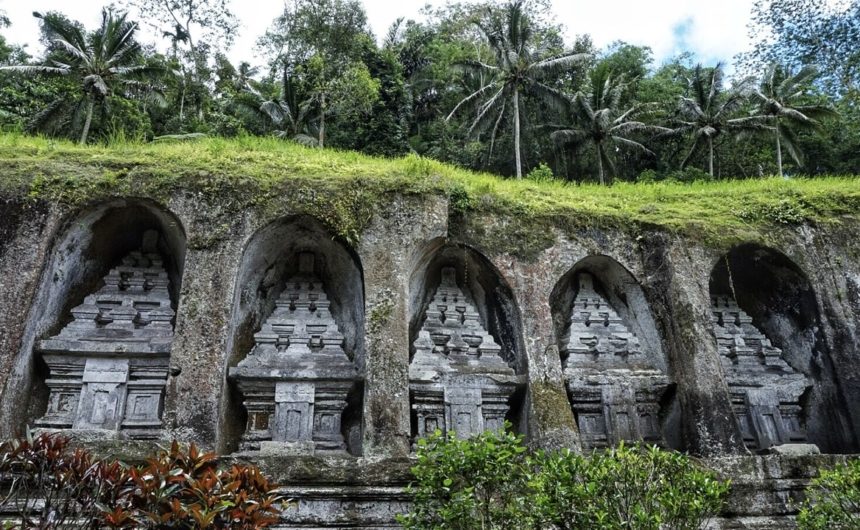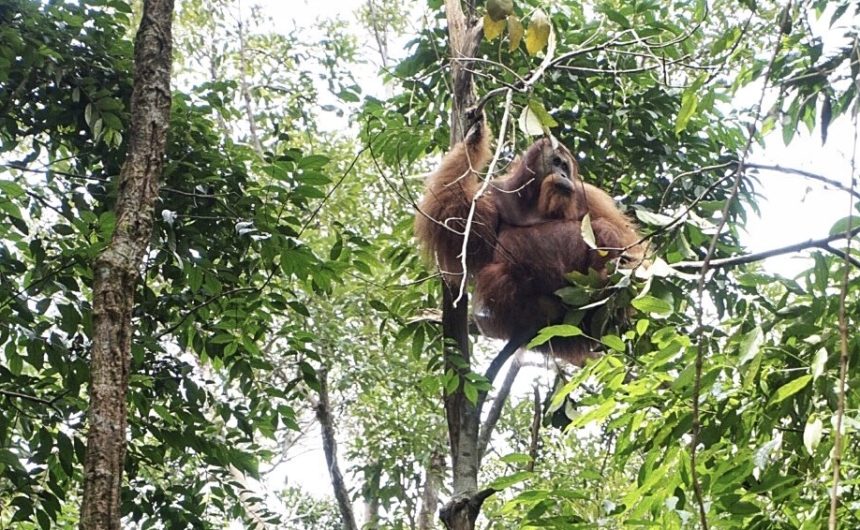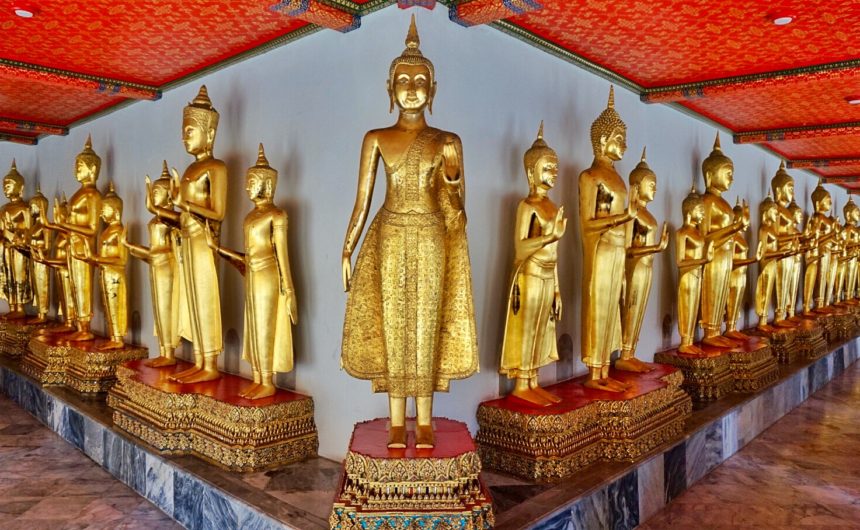- Angkor Wat Sunrise by Bicycle
- India – Everything You Need To Know Before You Go
- Myanmar – Everything You Need To Know Before You Go
- Vietnamese Food – 17 Must-Try Food and Drinks in Vietnam
- The Ultimate Guide to Exploring Ho Chi Minh City On a Budget
- Vietnam – Everything You Need To Know Before You Go
- Southeast Asia – Everything You Need To Know Before You Go
- 29 Reasons Why You Must Travel Southeast Asia
- How to Stay Safe in Southeast Asia
- Responsible Travel in Southeast Asia
- 20 Common Scams in Thailand And How To Avoid Them
- Ijen Volcano Blue Fire Hike in Indonesia
- Etiquette in Southeast Asia
- Orangutan Trek in Bukit Lawang (And What It’s Like To Get Chased By One)
- 14 Free and Cheap Things To Do In Ho Chi Minh City
- Indonesia – Everything You Need To Know Before You Go
- Laws in Singapore You Must Know Before You Go
- Thean Hou Temple in Kuala Lumpur
- The Ultimate Travel Guide for Singapore on a Budget
- 19 Fun And Free Things To Do In Singapore
- The Ultimate Guide to Exploring Kuala Lumpur On A Budget
- 14 Fun And Free Things To Do In Kuala Lumpur
- The 3 Most Beautiful Must-See Temples in Kuala Lumpur
- Malaysia – Everything You Need To Know Before You Go
Ijen is one of the 45 active volcanoes on the island of Java in Indonesia. Java is the most volcanic island on earth and one of its most spectacular and unusual volcanoes is Kawah Ijen (kawah means crater). Ijen is known for having one of the highest concentrations of sulphur in the world, which creates the surreal natural phenomenon known as the blue fire.
The sulphuric gases emerge from cracks in the volcano at an extremely high pressure and temperature of up to 600°C. When the sulphur comes in contact with the air, it ignites, which results in sending brilliant cobalt blue flames up to 5m/16ft high. Some of the gases condense into liquid sulphur, which causes the blue lava-like effect.
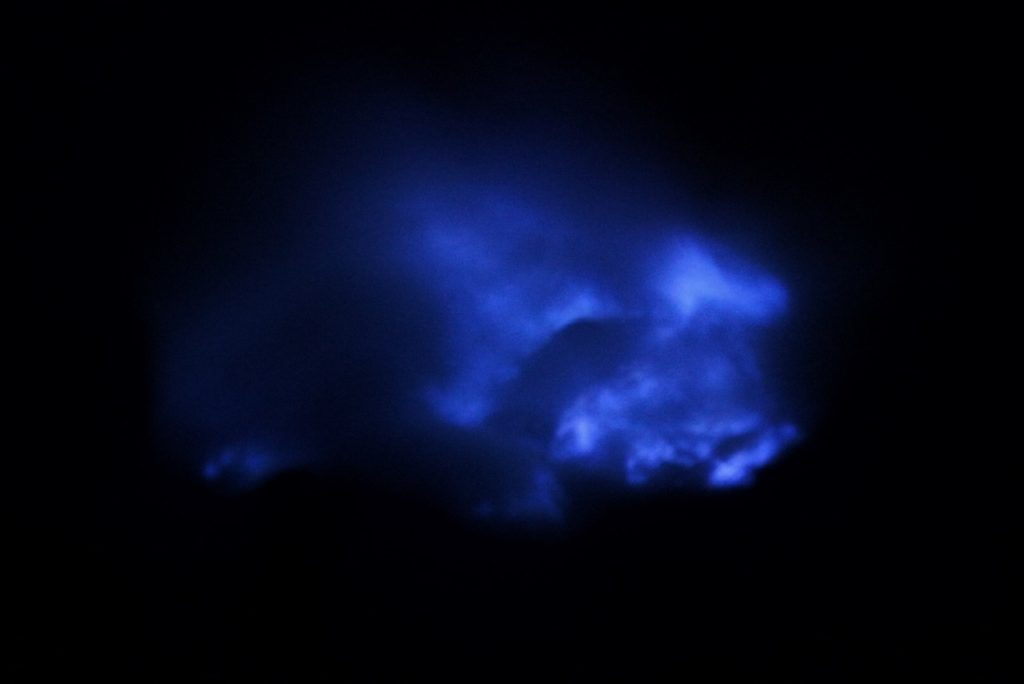
But the cool factor doesn’t stop there- inside Ijen’s crater is the world’s largest and most acidic sulphur lake, which creates a vibrant turquoise color.
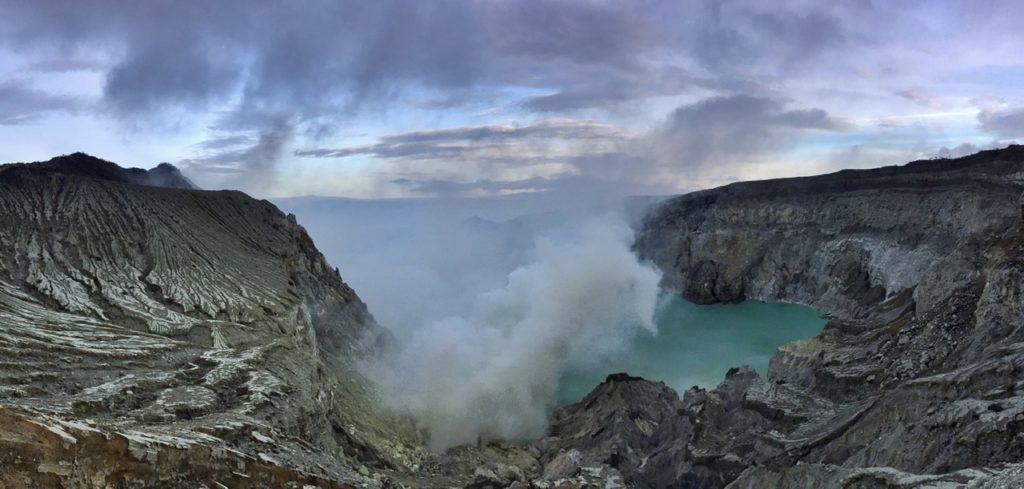
There’s nowhere else in the world like Ijen and there is so much more to Indonesia than just Bali.
THE STATS
Difficulty – Intermediate
Hiking time – 3 hours
Roundtrip – 6.6km
Elevation Gain – 646m
Summit altitude – 2769m
Season – Dry season (April to October)
THE HIKE
The trail to the crater rim is steep, but well-maintained. You don’t see anything while hiking in the dark, which can be a blessing because it’s a steep hike. But that also means there aren’t any sights to motivate you until you get to the top. Luckily it was a full moon when I hiked, so it provided some light.
Once at the top of Ijen crater, you get a gas mask to put on and then you start your descent into the crater. The 30-45 minute steep, rocky and dusty hike down is more difficult. Ijen is a working sulphur mine so there are many busy miners hiking up and down the path with very heavy loads of sulphur, so you need to stay out of their way.
Once at the bottom of Ijen crater, you can see the mesmerizing and unique vibrant blue fire. My hiking group and I hung around here for a while in complete awe. The wind constantly blows the sulphur gas around so it alternates between great visibility of the electric blue fire and horrendously toxic air quality.
You can choose to briefly go super close to the blue fire. It’s sooo cool and otherworldly, BUT sulphur is extremely toxic and intensely strong, so you cannot stay long, even with a gas mask. And it really stings your eyes.
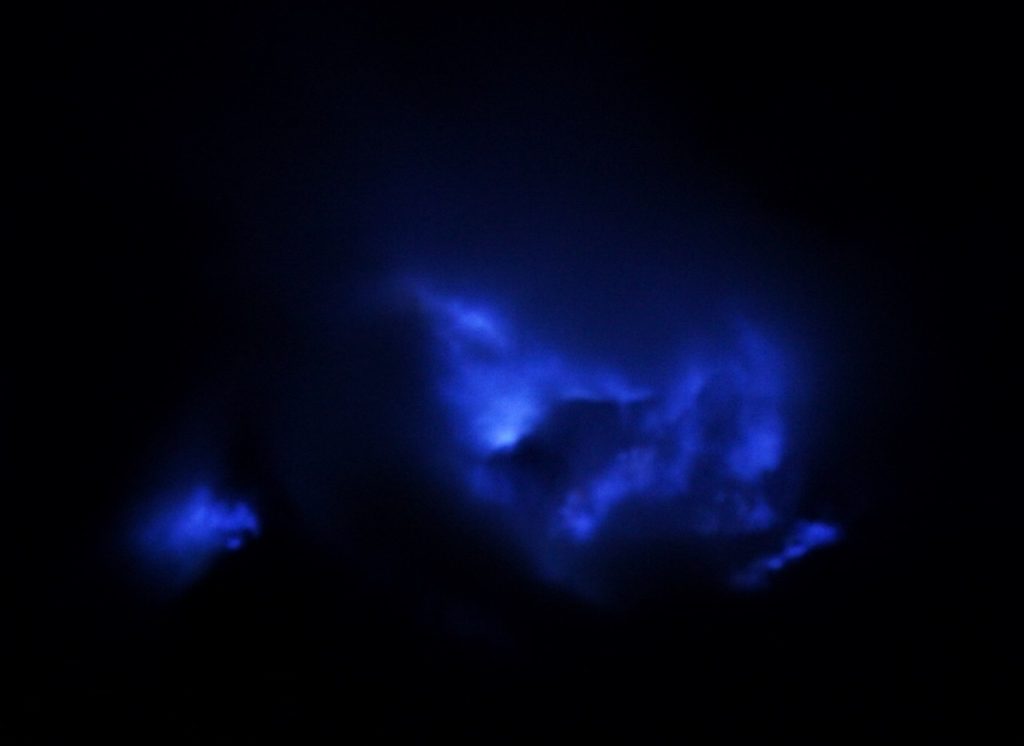
Daylight causes the disappearance of the blue fire, but that doesn’t make Ijen any less interesting. On a clear day, the sunrise is stunning and daylight reveals the beautiful turquoise lake sitting in the crater. You’ll likely want to hike back up to the crater rim to see the sunrise.
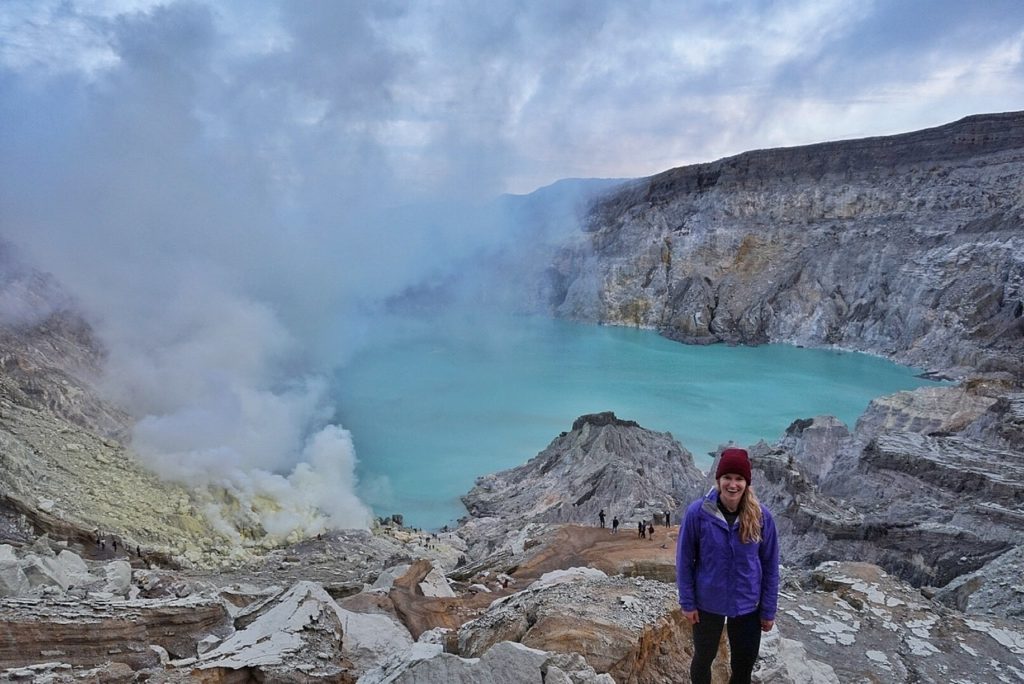
You can also hike along the rim of the crater. The views are surreal.
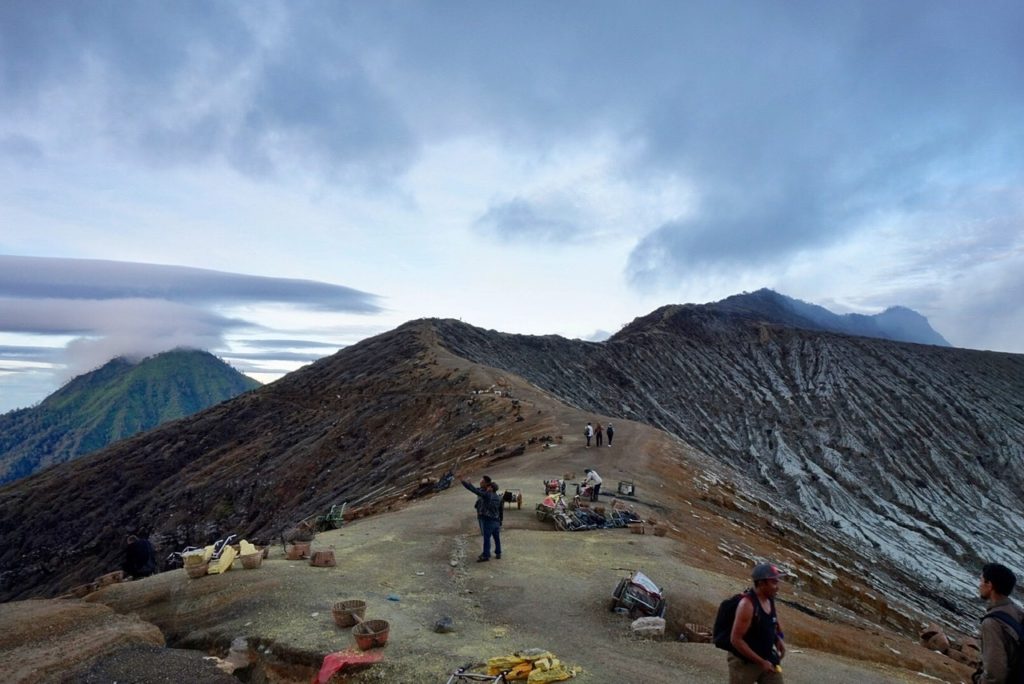
On the hike down, you can actually now see and enjoy the view of more volcanoes in the distance.
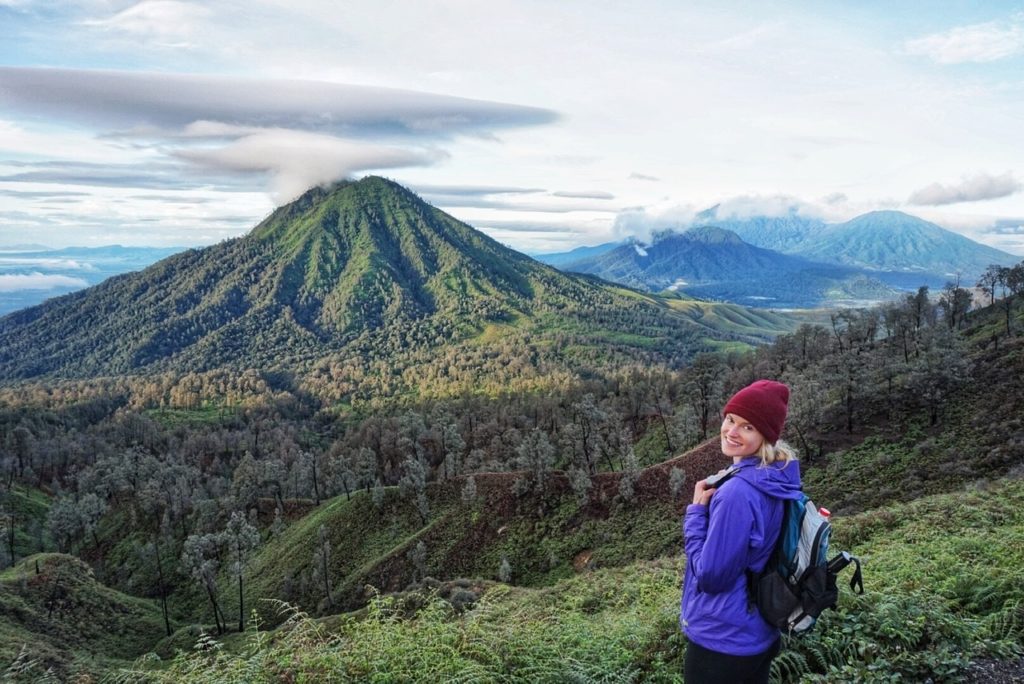
NEED TO KNOW
It’s 5-10°C at night and in the early morning, but it warms up during the day. And you’ll warm up with the uphill hike, which is why layers are great. And it’s very windy.
You will likely spend A LOT of time at the top of Ijen because it’s so stunning, unique and picturesque and the views completely change between day and night.
The turquoise lake looks inviting, but it’s acidic enough to dissolve metal.
The only bathroom facilities at Ijen are in the parking lot.
Nature is unpredictable and volatile, so it’s not guaranteed that you’ll see the blue fire. Sometimes it’s too dangerous to hike down into the crater.
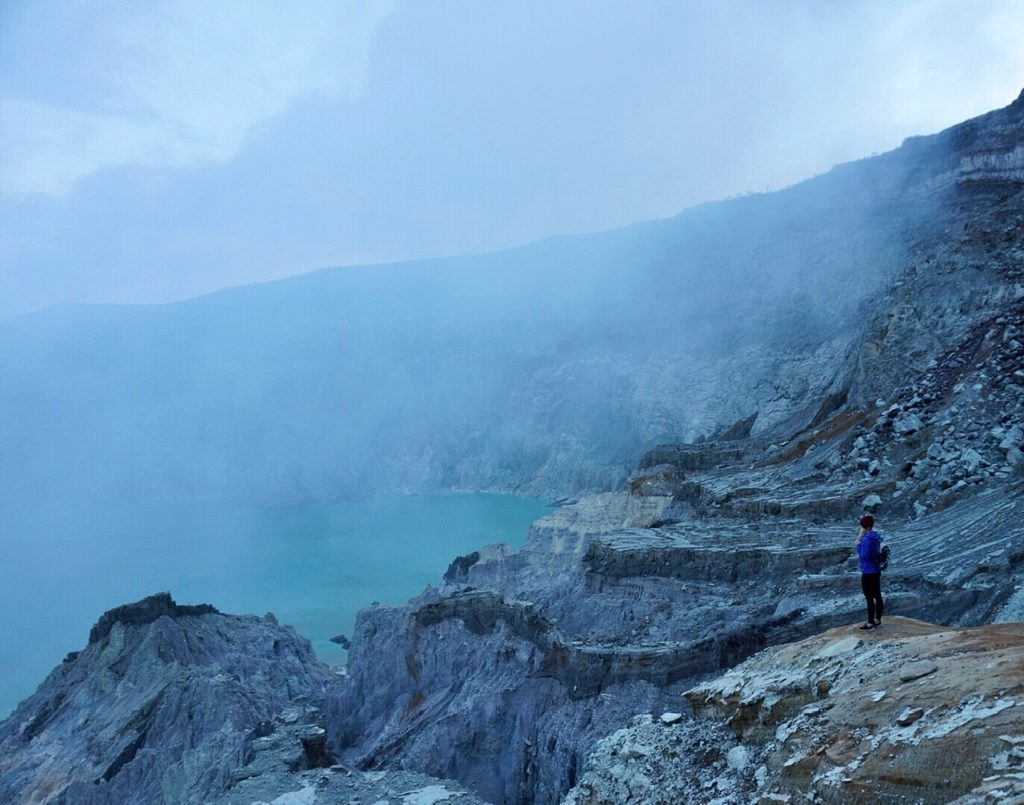
WHEN TO GO
The dry season, between April to October, is the best time to hike Ijen.
I hiked in mid-February and got very lucky with the weather during the wet season because it actually didn’t rain. However, other travelers who went to Ijen within the few days before me didn’t see anything. The rain had massively spoiled all the other sights I’d seen in Indonesia (Bromo, Borobodur, Yogakarta, etc) to the point where I considered leaving Indonesia early if Ijen was spoiled too. So reconsider traveling Indonesia in the wet season.
Try to avoid hiking Ijen on weekends and holidays.
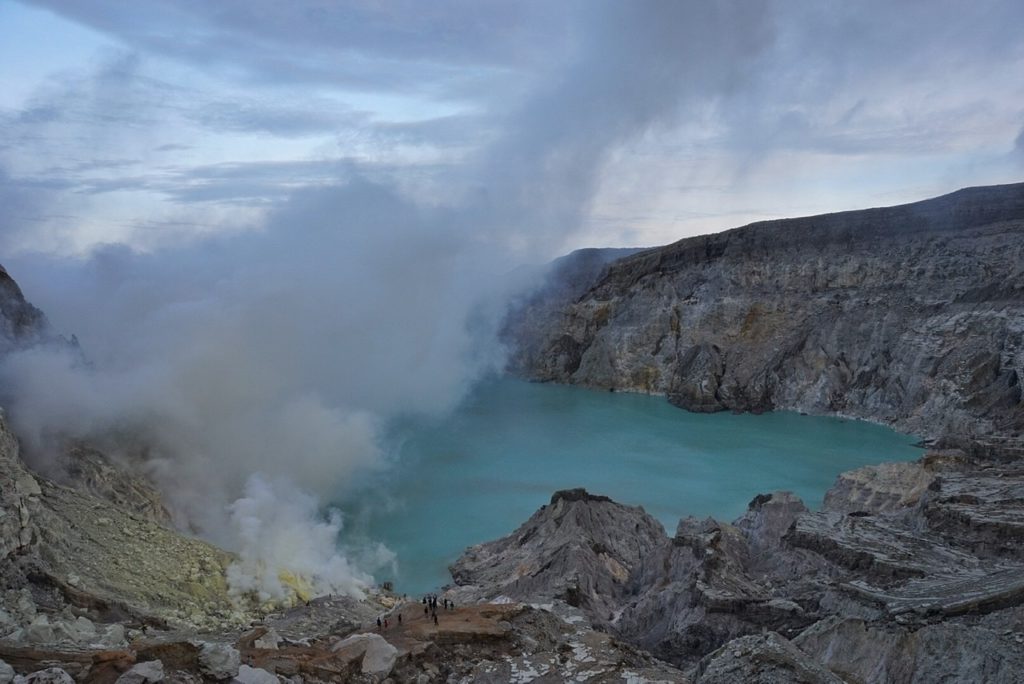
THE EFFECTS OF SULPHUR
Sulphur is toxic and inhaling too much can make you sick, even while wearing a gas mask. You must limit your time and proximity to the blue fire. If you have existing respiratory issues, like asthma, you will need to keep your distance.
Sulphur stings your eyes, so avoid wearing contact lenses.
Take off any jewelry before you hike or the sulphur will tarnish it.
You’ll need to wash the sulphur smell out of your clothes.
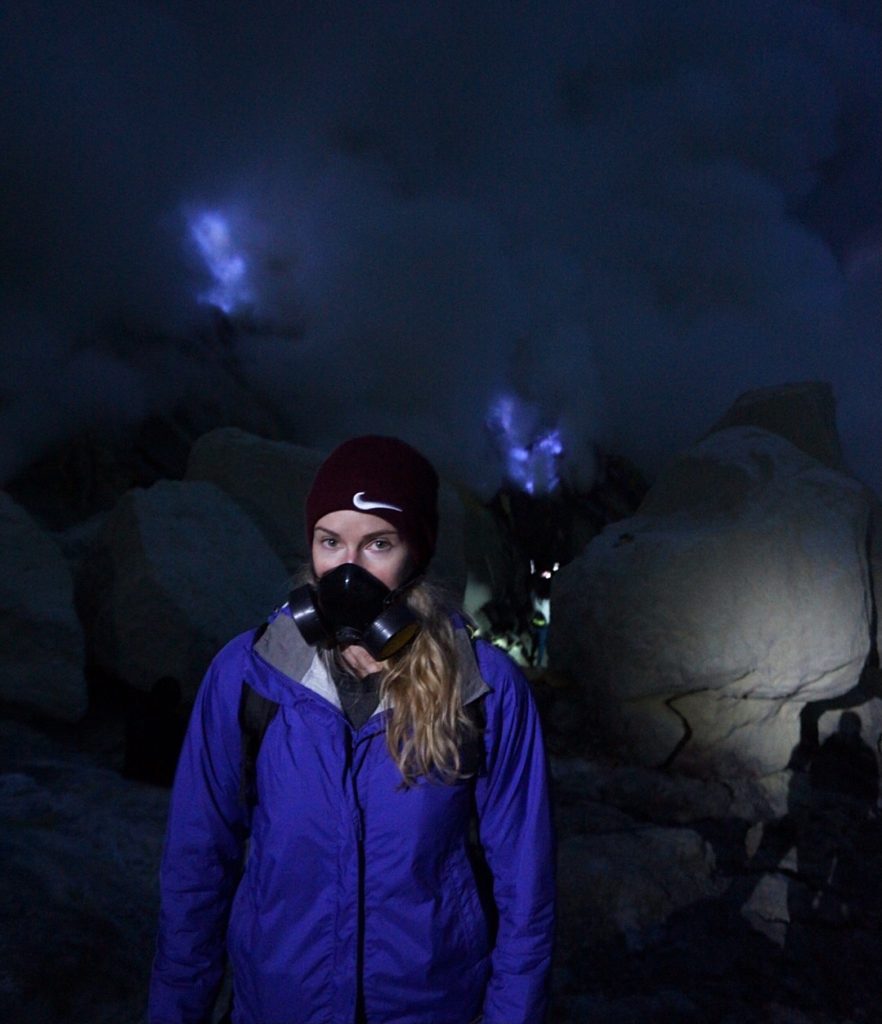
THE MINERS
Ijen is the most dangerous sulphur mining operation in the world, so consequently, the miners have one of the most dangerous jobs in the world.
Every day the miners hike to Ijen, often in sandals, and then inhale the toxic gases while they extract the sulphur, which is nicknamed “devil’s gold”. However, unlike the tourists who wear gas masks, the miners only use only a damp cloth to cover their nose and mouth.
Once their baskets are full of sulphur (which can weigh up to 90kg/200lbs), they load them onto their backs and carry them out of the crater and down the mountain. Most miners make this journey twice a day.
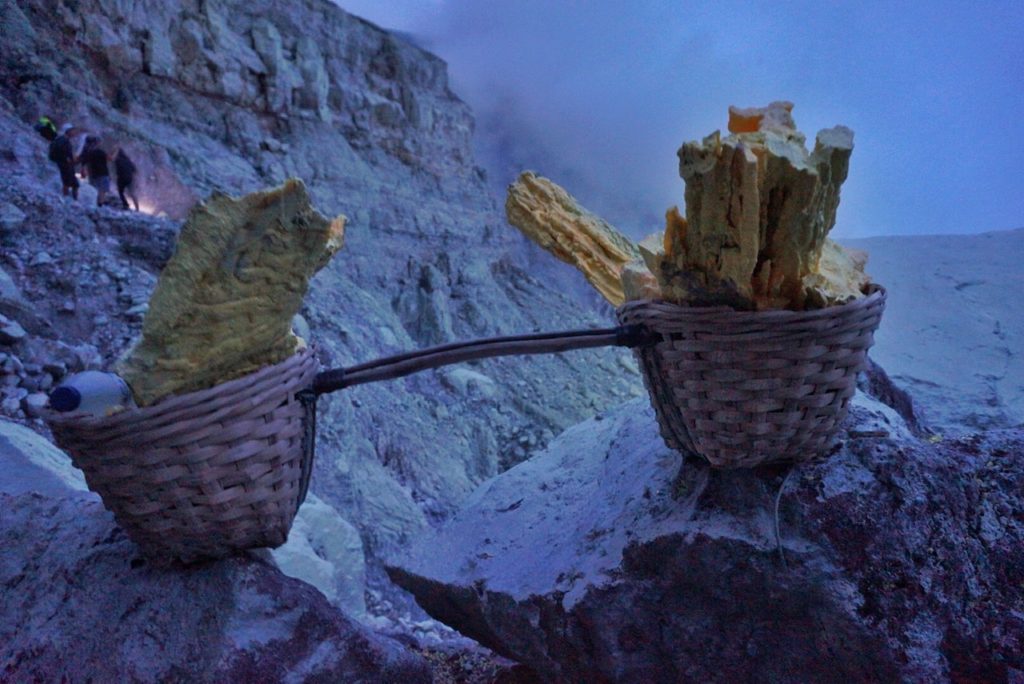
The miners risk their lives everyday by doing this back-breaking work in an extremely toxic environment and without any safety equipment. Yet they only make $10-$15US per day (payment is based on the weight of the sulphur they extract and transport), which is an above average paying job in this part of Indonesia. It’s completely eye-opening and heartbreaking.
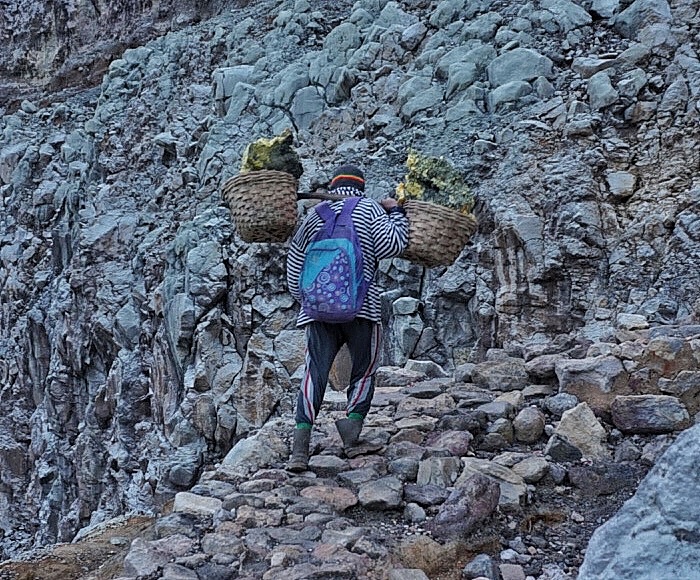
Many miners experience long-term health problems due to the daily exposure to the toxic sulphur.
Some miners sell small sulphur carvings and some offer rides in their cart back down Ijen for extra money, so you can help support them. Luckily, some of the miners are able to quit and become tour guides of Ijen instead.
Witnessing all this gives you a better understanding about life and reality in Indonesia. And it gives you perspective and helps you reflect on your own life and job, that you may complain about.
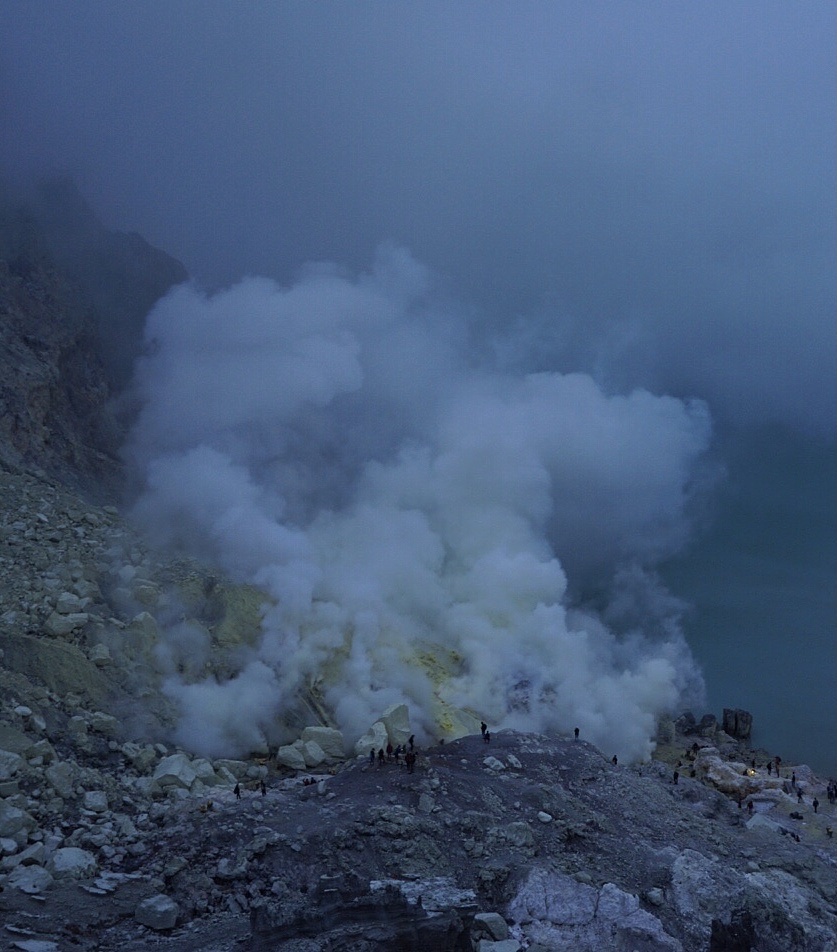
HOW TO PHOTOGRAPH THE BLUE FIRE
HOW TO GET THERE
Ijen is located on the far east of the island of Java. The closest major town to Ijen is Banyuwangi, so this is likely where you’ll stay before and/or after your hike. Banyuwangi is a short ferry ride from the west of Bali.
DO YOU NEED A GUIDE?
When you add up the cost of the entrance fee, the gas mask, and transportation to and from the crater, the money saved to do it on your own is negligible. However, if you do not bargain a good transportation price, it could easily cost more than a tour. Having everything organized for you makes your life so much easier, especially in the middle of the night and in the dark.
If you book a basic and generic tour (say through your guesthouse), you can expect it to be less of a guided experience and more on your own. I was fine with this, but if you’d prefer to have a guide who actually stays with you, do your research and spend a little more money. This tour company looks good.
It’s common to do a combo visit of Ijen and Bromo from Bali or from Yogyakarta. I attempted to visit Bromo and Ijen without a tour because I hate tours, but after my experience, I DO NOT recommend this. Just book a tour. It’s more so organized transport and accommodation than a tour. Navigating long distances without direct buses in rural areas in developing countries is a complete nightmare. And so is navigating these places in the middle of the night to start your hike in the dark. From Yogyakarta, I went to Bromo on my own and it was a nightmare, so I joined a tour to go to Ijen.
In my experience, navigating Ijen and Bromo on your own is not cheaper, it’s not faster and it’s an absolutely massive headache. A few other travelers I met had issues with this as well, but there are other blog posts about travelers doing it successfully on their own.
COST OF HIKING IJEN
ON YOUR OWN
150,000IDR ($11US) for foreigners
40,000IDR ($3US) for a gas mask
Bring or rent a headlamp.
Plus the cost of transport to Ijen in the middle of the night (which has the potential to be expensive)
BASIC TOUR FROM BANYUWANGI (2019)
Weekday tour – 275,000IDR ($20US)
Weekend tour – 325,000IDR ($24US)
Tour includes:
- Transport
- Entry
- Guide (who you’ll never see)
- Gas mask
- Headlamp
- Bottle of water
- Banana fritter
WHAT YOU NEED
- A camera that photographs well at night
- Hiking shoes
- Warm layers
- Warm hat and gloves
- Rain jacket/poncho
- Hiking poles (if you have bad knees)
- Water and snacks
- Toilet paper and hand sanitizer.
- Money for renting a gas mask and headlamp (if not on a tour)
- Remember to stretch before and after!
Hiking Ijen and seeing the orangutans in Sumatra were major highlights on my travels in Indonesia and all of Southeast Asia. Ijen is my second favorite volcano in the world so far. My first favorite is the Acatenango volcano hike in Guatemala, where you climb a volcano to watch another volcano erupt. It was literally the coolest thing I have ever seen in my life. It was completely mind-blowing.
MORE INFORMATION ON TRAVELING SOUTHEAST ASIA
INDONESIA – EVERYTHING YOU NEED TO KNOW BEFORE YOU GO
ORANGUTAN TREK IN BUKIT LAWANG (AND WHAT IT’S LIKE TO GET CHASED BY ONE)
SOUTHEAST ASIA – EVERYTHING YOU NEED TO KNOW BEFORE YOU GO
29 REASONS WHY YOU NEED TO TRAVEL TO SOUTHEAST ASIA
HOW TO STAY SAFE IN SOUTHEAST ASIA
RESPONSIBLE TRAVEL IN SOUTHEAST ASIA
WHAT TO EXPECT WHILE TRAVELING DEVELOPING COUNTRIES

